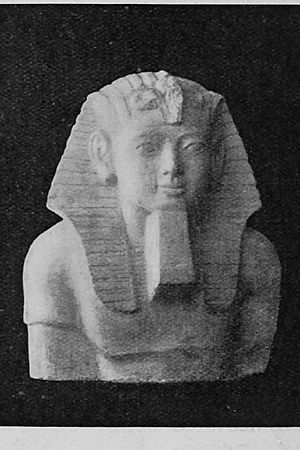Hakor facts for kids
Quick facts for kids Hakor |
|
|---|---|
| Achoris, Hakoris, Hagar | |

Upper half of statue of Hakor. In Cairo Museum
|
|
| Pharaoh | |
| Reign | 392/1–379/8 BCE (29th Dynasty) |
| Predecessor | Nepherites I (392/1 BCE); Psammuthes (390/89 BCE) |
| Successor | Psammuthes (391/0 BCE); Nepherites II (379/8 BCE) |
| Children | Nepherites II |
| Father | Nepherites I? |
Hakor (also called Achoris or Hakoris) was an ancient Egyptian pharaoh. He was a ruler during the 29th Dynasty. Hakor ruled for 13 years, which was more than half of his dynasty's total time. This makes him the most important pharaoh of this short-lived dynasty.
Contents
Hakor's Time as Pharaoh
Becoming Pharaoh: A Royal Struggle
When Hakor became pharaoh, there was a lot of debate about his connection to the pharaoh before him, Nepherites I. After Nepherites I died, it seems there was a fight for the throne. Two or even three people claimed to be the rightful pharaoh: Hakor, Psammuthes, and possibly someone named Muthis.
For a long time, historians wondered if Hakor was Nepherites' true heir or if he took the throne by force. In 1986, a historian named John D. Ray suggested a new idea. He thought Hakor was indeed Nepherites' heir. Ray believed Hakor ruled for about two years, then Psammuthes took over. But after just one year, Hakor managed to get his throne back. He then pretended the time Psammuthes ruled never happened. Many other historians agree with this idea.
Later, the pharaoh who started the next dynasty, Nectanebo I, called Hakor a "usurper" (someone who takes power illegally). However, some people think Hakor and Nectanebo might have been related. They could have both been connected to Nepherites I but were rivals for the throne.
Building Projects in Egypt
Once Hakor was firmly in power, he worked hard to show that he was the rightful pharaoh. He often highlighted his connection to Nepherites, whether it was real or not. He built many new structures and also fixed many older monuments built by pharaohs before him.
In Karnak, Hakor finished a special chapel for the sacred boat of the god Amun-Ra. This project was started by Psammuthes or maybe even Nepherites I. Hakor might also have started a temple complex in northern Saqqara. This complex was later made even bigger by Nectanebo II. We know about Hakor's building work in many places. These include Upper Egypt (like Luxor and Medinet Habu), the Temple of Hibis in the Kharga Oasis, and other places in Middle Egypt.
Dealing with Other Countries
Hakor seemed to follow the same foreign policy as Nepherites I. In a Greek play from 388 BCE, there's a mention of an alliance between the people of Athens and the Egyptians. This probably meant Athens was helping Evagoras I of Cyprus, who was also allied with Hakor. They were both fighting against the Achaemenids (the Persian Empire).
Another writer, Theopompus, wrote that Hakor also had an alliance with the Pisidians. A peace treaty between the Persians and Greeks in 387 BCE changed things. After that, Egypt and Cyprus were the only ones still fighting against the Persian king Artaxerxes II. The years that followed are a bit unclear. But it seems the Persians attacked Egypt in 385 BCE. After three years of war, the Egyptians managed to win against the invaders.
In 381 BCE, Hakor sent help to Evagoras. He sent money and 50 warships to help Evagoras fight the Persian king. However, in 380 BCE, Evagoras visited Egypt asking for more help. Hakor decided not to give him much more support and sent him back with only a small amount of money. Evagoras soon surrendered to Artaxerxes. But Hakor quickly joined a new alliance with Sparta and Glos, who was a supporter of Cyrus the Younger. Hakor even got the Athenian general Chabrias to work for him. But the Persian general Pharnabazus II convinced Athens to call Chabrias back home.
Hakor's Death and Successor
Hakor died in 379/8 BCE. He left his throne to his son, Nepherites II. However, Nepherites II was pharaoh for only four months. He was then overthrown by an army general from Sebennytos named Nectanebo I.
See also
 In Spanish: Acoris para niños
In Spanish: Acoris para niños


